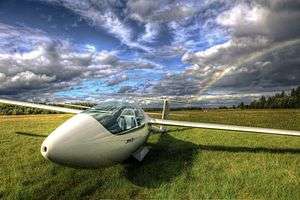Jonker JS-1 Revelation
| JS-1 Revelation | |
|---|---|
 | |
| Role | High performance Sailplane |
| National origin | South Africa |
| Manufacturer | Jonker Sailplanes |
| First flight | 12 December 2006 |
| Number built | 100[1] (as of 2015) |
|
|} The Jonker JS-1 Revelation is a glider built of glass-fibre, carbon fibre and Kevlar. It is available with an 18-metre span for the 18 metre class or a 21-metre span for the Open class. The manufacturer is Jonker Sailplanes of Potchefstroom South Africa, founded in 2004 by two brothers, Attie and Uys Jonker. The structural and chief designer is Attie Jonker, while the airfoil and main aerodynamic features were developed by Johan Bosman in co-operation with the Delft University of Technology. 18 metre versionsThe wing has full-span flaperons, an elliptical planform and uses winglets. It is in 4 pieces, each tip is 1.5 metres. Two novel features are:
The first flight of the JS-1 was on 12 December 2006. Series production then started and up to July 2012 about 34 had been produced[2] Although it has been built to EASA standards, discussions on EASA certification are still continuing (as at July 2012). Attie Jonker won the 18 metre class South African National Championship in 2008 with a JS-1 Revelation. 21 metre versionA new version, JS1C-21m, with 3 metre wing-tips, which increase the span to 21 metres, has been developed. The first flight was on 22 March 2012. Because of the higher wing loads and increased maximum take-off mass of 720 kg (increased from 600 kg), the wing/wingtip junction has been redesigned including stronger wing spar caps and thicker wing-tip spars. All future JS1 Revelations will be compatible with the optional 21m wing-tips. The new wing-tips have water tanks each with a capacity of 17 litres of ballast which can be jettisoned separately from the main wing and fin tanks. Theoretical performance gives a claimed best glide of around 1:60, and with the maximum wing loading of 58.7 kg/m2 and the polar remaining flat at high cruise speeds. The manufacturers state that it is competitive at the highest level with other Open Class gliders. The results (2nd, 3rd and three other places in the top ten in the 2014 World Gliding Championships Open Class[Notes 1]) supports this assertion.[3] Variants
Specifications (JS-1B)General characteristics
Performance
See also
Notes
References
External links | |